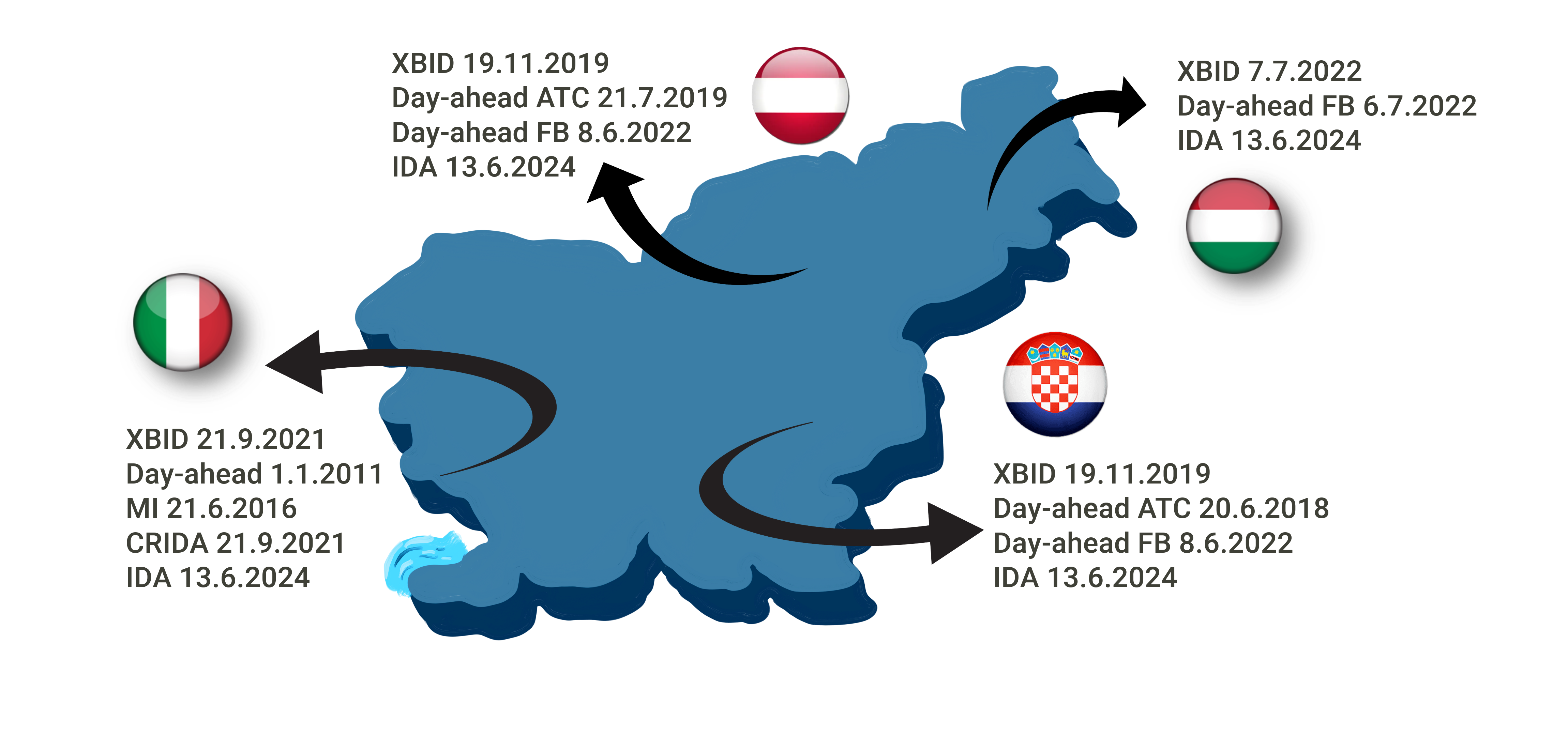Market Coupling
Market Coupling is a process whereby day-ahead and intraday bids for electricity are placed on a power exchange without cross-border capacities being allocated in advance. During the market coupling process, power exchanges match the bids on the single pan-European market and allocate cross-border transmission capacity in the most efficient way possible. Before the introduction of the market coupling cross-border capacity and electricity had to be purchased separately.
The main benefits of Market Coupling are:
- Maximized social welfare → Market Coupling eliminates insufficient cross-border allocation and ensures that consumers pay a fair price for electricity. This encourages competition and lowers costs for end-users.
- Removed risks and costs of trading transmission capacity and energy separately → implicit auctions enable a one-step process that maximizes and optimizes use of existing cross-border capacities.
- Improved energy security → Interconnected markets can rely on each other during supply shortages or unexpected disruptions, improving energy security by reducing dependence on a single energy source or supplier.
- Facilitation of renewable energy → By creating a more integrated market, market coupling can facilitate the integration of different renewable energy sources such as wind and solar power.
In summary, market coupling in the European electricity market creates a more efficient and integrated market with greater competition and price convergence. This benefits both consumers and producers while encouraging investment in new infrastructure and renewable energy sources.
The History of European and Slovenian market coupling
Market coupling started in 2006 as a local initiative between the French, Belgian and Dutch day-ahead markets. In the following years, extension was carried out to Central Western Europe, the Nordic countries and Northwestern Europe. The process, initially developed on a commercial basis by several European power exchanges has been regulated in 2015 through Guideline on capacity allocation and congestion management (Regulation 2015/1222), setting the rules for further operation and development.
BSP was founded in 2008 and for the first few years it operated only in the local market. The first successfully implemented Market Coupling project was a Day-ahead coupling on the Slovenian-Italian border in early 2011. The borders with Austria, Croatia and Hungary were coupled in 2016, 2018 and 2022 respectively, starting with the Day-ahead segment. Intraday market coupling followed soon after.
On June 22, 2016, BSP, together with its Italian partners, introduced implicit Intraday auctions (MI) on the Slovenian-Italian border. This was a pilot European project that later evolved into ‘Complementary Regional Intraday Auctions’ (CRIDA) and was replaced by pan-European Intraday auctions (IDA) on June13, 2024.
On June 8, 2022, BSP, along with ten Nominated Electricity Market Operators (NEMOs) and 16 Transmission System Operators (TSOs), entered the Core Capacity calculation region as part of day-ahead market integration. Since then, core calculations have been carried out on all borders except the Italian one.

Legal Basis
On August 14, 2015, the Commission Regulation (EU) No 2015/1222 of 24 July 2015 establishing the Guideline on Capacity Allocation and Congestion Management (CACM), entered into force. This Regulation sets the rules for the functioning of the cross-border day-ahead and intraday market in the European Union and made the market coupling legally binding throughout the European Union.
The CACM guideline introduced a Nominated Electricity Market Operator (NEMO), an entity to operate, maintain and further develop the Single Day-Ahead Market Coupling (SDAC) and the Single Intraday Market Coupling (SIDC).
In December 2015, Slovenian Energy Agency (AGEN) appointed BSP Energy Exchange LLC as the nominated electricity market operator for a period of 4 years within the territory of the Republic of Slovenia. The NEMO status has been extended in 2019 and 2023.
Governance structure
All NEMOs and TSOs work together to achieve a truly integrated European electricity market. Cooperation is achieved through joint governance structure called Market Coupling Steering Committee (MCSC), which includes representatives of all parties involved.
MCSC activities are supported by horizontal joint groups that address the legal, financial and communication aspects of Market Coupling.
In addition, on the SDAC side, four joint groups deal with the following: Market and System Design (SDAC MSD), Operational tasks, Procedures and Change control management (SDAC OPSCOM), Simulation Facility development and maintenance (SDAC SIM TF), and Quality Assurance and Release Management (SDAC QARM) with focus on testing and implementation of new projects (such as introduction of 15 min MTU).
On the SIDC side there are three joint groups dealing with: Operations Committee (SIDC OPSCOM) with Operational Task Force (SIDC OTF) as a subgroup dedicated to Procedures, Quality Assurance and Release Management (SIDC QARM) with dedicated testing subgroup (SIDC XTG), and Market and System Design (SIDC MSD).